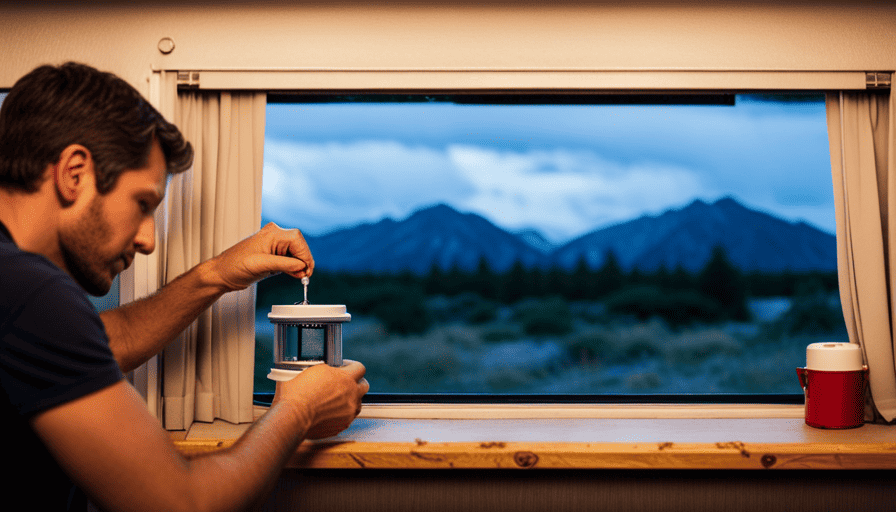Tired of feeling the cold or heat seeping through your camper windows? I certainly was. This led me to take matters into my own hands and find a solution to better insulate my camper windows. And I have to say, it made a huge difference in the comfort level.
In this article, I’m going to share with you my knowledge and practical tips on how to insulate camper windows. From sealing gaps and cracks to using insulated window coverings and reflective film, I’ve got you covered. I’ll even delve into more advanced options like double glazing and window replacement.
By the end of this article, you’ll have all the tools and techniques you need to keep your camper cozy in the winter and cool in the summer. So let’s get started and make your camper a comfortable haven, no matter the weather outside.
Key Takeaways
- Evaluate current window insulation
- Use caulking or weatherstripping to seal gaps and cracks
- Consider using insulated window coverings or inserts
- Regular maintenance and cleaning of windows is essential
Assess the Current Insulation of Your Windows
Take a moment to feel the cool breeze seeping through the cracks and see if any drafts are coming in from your camper windows. Evaluating the effectiveness of your current window insulation is the first step in determining how to insulate your camper windows.
Insulation plays a vital role in maintaining a comfortable temperature inside your camper and reducing energy consumption. Start by checking the condition of the existing insulation. Look for any signs of wear, such as tears or gaps around the window frames. This will give you an idea of whether it needs to be upgraded or replaced altogether.
Additionally, consider the type of insulation currently installed. Is it providing sufficient thermal protection? If not, it may be worth exploring alternative options such as thermal curtains, reflective window film, or insulating window inserts. These upgrades can significantly improve the insulation properties of your camper windows.
Once you have evaluated the effectiveness of your current insulation and considered potential upgrade options, you can move on to the next step of sealing any gaps or cracks around the window frames. This will further enhance the insulation and prevent any unwanted drafts from entering your camper.
Seal any Gaps or Cracks around the Window Frames
To effectively seal any gaps or cracks around your window frames, you’ll want to start by thoroughly inspecting the area for any potential air leaks. Did you know that according to a study by the U.S. Department of Energy, air leaks can account for up to 25% of heat loss in a typical home? That’s why it’s crucial to address any gaps or cracks in your camper windows to prevent heat loss and maintain a comfortable interior temperature.
To begin, use a flashlight to carefully examine the window frames from both the inside and outside of your camper. Look for any visible cracks, holes, or openings where air might be able to escape. Common areas to check include the corners of the frames, the meeting point of the window sash and frame, and the space between the window and the wall.
Once you have identified the areas that need attention, you can start sealing them. There are various sealing techniques you can use, such as caulking or weatherstripping. Caulking is ideal for sealing larger gaps or cracks, while weatherstripping is great for smaller spaces. Choose a high-quality sealant that’s specifically designed for outdoor use and is compatible with your camper’s window materials.
After applying the sealant, make sure to smooth it out with a putty knife or your finger to create a tight seal. Allow the sealant to dry completely before testing for any remaining air leaks. If needed, repeat the sealing process until all gaps and cracks are properly sealed, preventing heat loss and improving energy efficiency in your camper.
Now that you’ve sealed any gaps or cracks around your window frames, it’s time to move on to the next step: installing insulated window coverings. These coverings will provide an additional layer of insulation, further reducing heat loss and improving the overall comfort of your camper.
Install Insulated Window Coverings
Now it’s time to enhance your camper’s coziness by adding insulated window coverings. Insulated window coverings are a great addition to your camper as they provide several benefits. Here are five reasons why you should consider installing insulated window coverings:
-
Energy efficiency: Insulated window coverings help to keep the heat inside during colder months and block out the heat during warmer months. This can significantly reduce your heating and cooling costs.
-
Noise reduction: The thick and dense material of insulated window coverings helps to buffer outside noises, creating a quieter and more peaceful environment inside your camper.
-
Privacy: Insulated window coverings offer an extra layer of privacy, preventing prying eyes from peering into your camper.
-
Light control: You have full control over the amount of light that enters your camper. Whether you want to let in natural sunlight or block out the bright morning rays, insulated window coverings can easily adjust to your preference.
-
Insulation: Insulated window coverings act as an additional layer of insulation, helping to regulate the temperature inside your camper and keep it comfortable.
Now that you’ve installed insulated window coverings, let’s move on to the next step of enhancing your camper’s insulation by using reflective window film.
Use Reflective Window Film
Enhance the comfort of your camper and create a mesmerizing oasis with the use of reflective window film. Reflective window film is a great option for insulating camper windows, as it offers numerous benefits. It not only reduces heat transfer but also blocks harmful UV rays and provides increased privacy.
The film is designed with a reflective coating that reflects sunlight away from the windows, keeping the interior cooler on hot summer days. This can help reduce the need for excessive air conditioning and save energy.
When installing reflective window film, there are a few tips to keep in mind. First, make sure to thoroughly clean the windows before applying the film to ensure proper adhesion. Next, measure and cut the film to fit the size of each window precisely. It’s also important to apply the film on a warm day, as this’ll make it easier to manipulate and remove any air bubbles. Lastly, use a squeegee to smooth out the film and remove any excess water or air pockets.
By using reflective window film on your camper windows, you can create a cooler and more comfortable living space while enjoying the benefits of increased privacy and UV protection.
Now, let’s move on to the next section about adding insulated window inserts to further improve insulation and reduce heat loss.
Add Insulated Window Inserts
Boost the comfort and energy efficiency of your camper with the addition of insulated window inserts. Insulated window panels are a great way to keep the cold air out and the warm air in during those chilly camping trips. They’re easy to install and can be a cost-effective solution to insulating your camper windows.
Here are three reasons why insulated window inserts are a smart choice for camper window insulation:
-
Increased insulation: Insulated window panels provide an extra layer of insulation to your camper windows, helping to keep the temperature inside more stable. This can make a big difference in both hot and cold weather, allowing you to stay comfortable no matter the season.
-
DIY installation: You don’t need to be a professional to install insulated window inserts. Many companies offer DIY window insulation kits that come with everything you need to get the job done. With just a few simple steps, you can have your camper windows insulated and ready for your next adventure.
-
Versatility: Insulated window inserts come in a variety of sizes and shapes, making them suitable for any camper window. Whether you have small windows or large panoramic ones, there’s an option out there for you.
By adding insulated window inserts to your camper, you can significantly improve its energy efficiency and comfort. Once you’ve installed the inserts, the next step is to apply weatherstripping to the window edges, ensuring a tight seal and maximum insulation.
Apply Weatherstripping to the Window Edges
Make sure to apply weatherstripping to the edges of your windows – can you imagine the difference it will make in keeping out drafts and maximizing insulation? By adding weatherstripping to your camper windows, you can significantly improve energy efficiency and reduce heat loss. This simple and cost-effective solution is a must for anyone looking to stay warm and cozy during those chilly camping trips.
Weatherstripping creates a seal between the window and the frame, preventing cold air from seeping in and warm air from escaping. It acts as a barrier, blocking drafts and ensuring that the interior of your camper remains comfortable. Not only does weatherstripping enhance insulation, but it also helps to reduce noise pollution from outside.
To give you an idea of the impact weatherstripping can have on your camper, take a look at the table below:
| Without Weatherstripping | With Weatherstripping |
|---|---|
| Cold drafts | Cozy interior |
| High energy consumption | Reduced heating costs |
| Noise from outside | Peaceful ambiance |
| Uneven temperature | Consistent warmth |
Applying weatherstripping is a straightforward process that requires minimal time and effort. You can find weatherstripping kits at most hardware stores, and they usually come with easy-to-follow instructions. Once you’ve applied the weatherstripping, you’ll immediately notice a difference in comfort and energy efficiency.
To further enhance insulation in your camper, the next step is to use thermal curtains or drapes. These will provide an additional layer of insulation and help to block out cold air.
Use Thermal Curtains or Drapes
To improve the insulation in your camper, consider using thermal curtains or drapes to create an extra layer of warmth and block out cold air. Thermal curtains are designed to trap heat inside and prevent it from escaping through the windows. They’re made with a thick, insulating material that helps to maintain a comfortable temperature inside the camper.
One of the main benefits of using thermal curtains is that they can significantly reduce heat loss, which can help to lower your energy bills. When choosing the right drapes for insulation, there are a few factors to consider. First, look for curtains that are made with a thermal lining. This lining helps to insulate the window and prevent cold air from seeping in. Additionally, consider the color and thickness of the curtains. Darker colors tend to absorb more heat, while thicker curtains provide better insulation.
It’s also important to measure your windows accurately to ensure that the curtains you choose will fit properly and cover the entire window. To further enhance the insulation in your camper, you may want to consider double glazing or window replacement. These options can provide even better insulation and help to reduce heat loss. By combining different methods, you can create a well-insulated space that’s comfortable and energy-efficient.
Consider Double Glazing or Window Replacement
If you want to improve the insulation in your camper and create a cozier space, have you ever considered the option of double glazing or window replacement? This is a great way to enhance the energy efficiency of your camper and reduce window condensation. Double glazing involves installing a second layer of glass to create an insulating barrier, while window replacement allows you to choose windows with better insulation properties. Both options can significantly improve the thermal efficiency of your camper, making it more comfortable in both hot and cold weather.
To help you understand the benefits of double glazing or window replacement, let’s compare the two options in the table below:
| Double Glazing | Window Replacement |
|---|---|
| Provides an extra layer of insulation | Allows you to choose windows with higher insulation properties |
| Reduces external noise | Improves energy efficiency |
| Helps prevent window condensation | Enhances the overall appearance of your camper |
| Requires professional installation | Requires professional installation |
| Can be more expensive upfront | Cost varies depending on the type of windows chosen |
Considering these factors, double glazing or window replacement can be excellent choices for improving insulation in your camper. However, if you’re looking for a simpler and more affordable option, the next subtopic will discuss the use of insulating window blinds or shades.
Use Insulating Window Blinds or Shades
Consider using insulating window blinds or shades to improve the energy efficiency of your camper and create a more comfortable space with reduced heat loss or gain. Did you know that insulating blinds can reduce heat transfer through windows by up to 45%?
Insulating window blinds or shades are a great option for camper owners looking to enhance their insulation without investing in double glazing or window replacement. One of the major advantages of insulating blinds or shades is their ability to block out sunlight and heat during summer months, keeping your camper cool and comfortable. They also provide an additional layer of insulation during colder seasons, reducing heat loss and preventing cold drafts from seeping in. Moreover, these blinds or shades offer privacy and can effectively block out unwanted noise from the outside.
However, it is important to weigh the pros and cons before choosing this option. While insulating blinds or shades can improve energy efficiency, they may limit the amount of natural light entering your camper. Additionally, they require regular cleaning and maintenance to ensure optimal performance.
In addition to insulating blinds or shades, there are alternative window insulation options available such as window films, weatherstripping, or thermal curtains. These options may suit different preferences and budgets.
To further enhance your camper’s window insulation, regularly maintain and clean your windows for optimal insulation. This will ensure that your camper remains energy efficient and comfortable throughout the year.
Regularly Maintain and Clean Your Windows for Optimal Insulation
Maintaining and cleaning your windows regularly is key to maximizing insulation and ensuring a cozy and energy-efficient space. When it comes to camper windows, proper maintenance is crucial in preventing condensation buildup and maintaining window cleanliness.
Here are some practical tips to help you keep your camper windows in top shape:
-
Regularly clean the windows: Wipe down your windows with a mild glass cleaner and a soft cloth, both inside and outside. This will remove any dirt, dust, or smudges that can hinder the insulating properties of the windows.
-
Inspect and repair seals: Check the seals around your windows for any signs of wear or damage. Cracked or loose seals can allow drafts and moisture to enter your camper, compromising its insulation. If you notice any issues, replace or repair the seals promptly.
-
Use a dehumidifier: Excess moisture in your camper can lead to condensation on the windows, which can reduce their insulating capabilities. Consider using a dehumidifier to maintain optimal humidity levels and prevent condensation buildup.
-
Ventilate your camper: Proper ventilation is essential in preventing condensation and maintaining a comfortable environment. Open windows and use roof vents or fans to circulate air and reduce moisture buildup.
By following these maintenance tips and keeping your windows clean, you can ensure optimal insulation in your camper and create a cozy and energy-efficient living space.
Frequently Asked Questions
What are the benefits of using reflective window film?
Reflective window film offers several benefits compared to tinted window film. It effectively blocks out sunlight, reducing heat and glare inside the camper. This feature helps to maintain a comfortable temperature and protects the interior from fading or damage caused by UV rays.
Additionally, reflective window film provides increased privacy by making it difficult for outsiders to see inside. However, it’s important to note that there are alternative insulation methods available, such as using insulated curtains or window covers, which can also provide effective insulation for camper windows.
Can I use weatherstripping on both the interior and exterior of the window?
Yes, you can use weatherstripping on both the interior and exterior of the window. Interior weatherstripping is typically used to seal any gaps or cracks between the window frame and the wall. It helps to prevent drafts and improve insulation.
Exterior weatherstripping, on the other hand, is used to seal the window itself, preventing air leakage. However, there are also alternative window insulation options available, such as using window film or thermal curtains, which can also help improve insulation and energy efficiency.
How do insulated window inserts work?
Insulated window inserts are a great way to improve energy efficiency and comfort in your home. These inserts work by creating a barrier between the interior and exterior of the window, reducing heat transfer and preventing drafts. They are typically made of high-quality materials, such as insulated glass or acrylic panels.
If you’re looking for a DIY option, you can also consider using insulated window blinds or DIY window insulation kits. These options provide a cost-effective solution for improving insulation in your camper windows.
Are thermal curtains or drapes effective in insulating camper windows?
Thermal curtains and drapes can be an effective alternative for insulating camper windows. They work by trapping air between the window and the curtain, creating a layer of insulation. However, it’s important to note that thermal curtains alone may not provide as much insulation as other options like window film. Window film is a thin layer applied directly to the window, providing a more effective barrier against heat loss. Therefore, if you’re looking for maximum insulation, window film would be a better choice.
How often should I clean and maintain my camper windows for optimal insulation?
For optimal insulation, it’s important to clean and maintain your camper windows regularly. The cleaning frequency will depend on various factors such as the environment you’re camping in and how often you use your camper.
As a general rule, it’s recommended to clean the windows at least once a month. Use a mild detergent and a soft cloth to remove any dirt or debris. Additionally, inspect the windows for any signs of damage and repair or replace as needed to ensure maximum insulation.
Can the Method for Insulating the Bottom of a Camper be Applied to Windows as well?
When considering insulating the camper bottom, it’s important to remember that the same method might not apply to windows. The materials and insulation needs for windows are different than those for the bottom of a camper. It’s best to research specific window insulation techniques for the best results.
Conclusion
In conclusion, insulating camper windows is crucial for maintaining a comfortable and energy-efficient living space on the road. By properly assessing the current insulation and sealing any gaps, and installing insulated window coverings, you can significantly reduce heat loss or gain.
One interesting statistic to consider is that properly insulated windows can reduce energy loss by up to 30%, allowing you to enjoy a cozy camper experience while saving on heating and cooling costs.
Remember to regularly maintain and clean your windows to ensure optimal insulation and longevity.
Safe travels!










